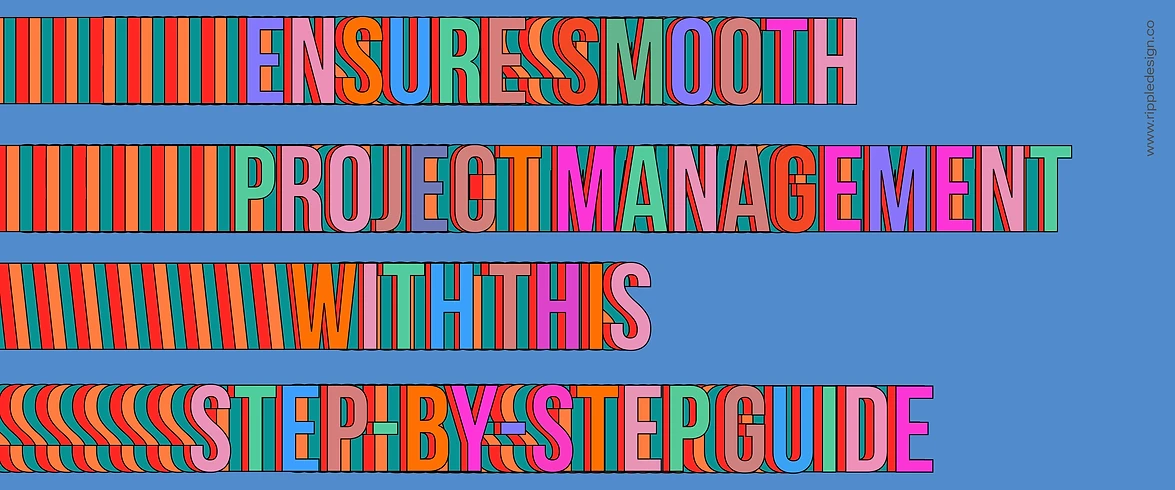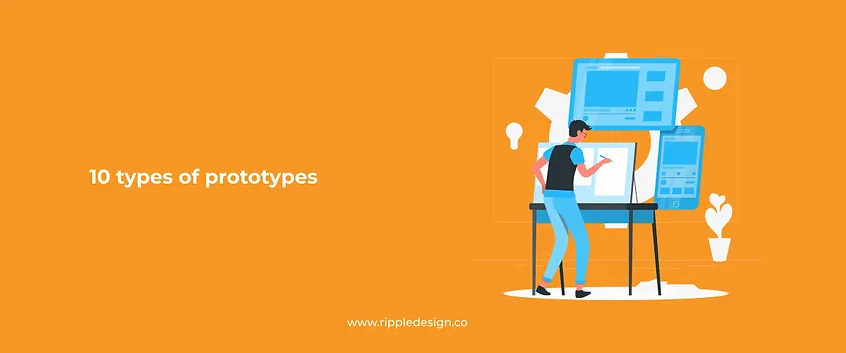Ensure smooth project management with this step-by-step guide
Ensure smooth project management with this step-by-step guide
Ensure smooth project management with this step-by-step guide
Sunny Haladker
Co-founder
Co-founder
5 Min ago
5 Min ago
6 Feb 2022
6 Feb 2022




Managing people is by far one of the most excruciating jobs out there. Project managers are those courageous beings who take up this job and act as a link to fulfill an organization's budget and deadline needs while simultaneously maintaining the most critical tasks managed at the forefront.
Regardless of the project size and if you’re hired as a freelancer or in-house, project managers get taken by several challenging tasks such as launching a project and ensuring that everything runs smoothly by collaborating with team members & clients.
A good project manager brings all the stakeholders to the table and coordinates their inputs effectively. This highly demanding job deserves the credit of not letting a company leave its business at the mercy of its employees.
While different types of projects demand different skills, some common ground rules can set you apart in your project management process and provide a simplistic as well as an effective strategy. So, without any further ado, let's dig into the precious steps that lead you straight to the answers about how to ensure smooth project management.
The Takeoff
The first project management step is to settle on the idea of a project and scratch out the concept. Then comes the final agreement that the idea or concept will be taken off the board and materialized. Now that you have the concept, you better be going for research and prepare a rough roadmap of how the concept will become a reality and then pitch it to the relevant stakeholders for review and approval. Remember, as a manager and leader, it's your key responsibility to notify every stakeholder involved and collaborate with them for their input and approval.
In this stage, depending upon the idea, you may experience some or many changes in the original concept as this phase is more about discussions and deliberations. For instance, if the client wants to add a new feature, then you’ll need to consult the lead of your development team to figure out a game plan. Meanwhile, keeping the client in the loop to inform them where their money is being spent is also cohesive.
The concept materialization stage aims to analyze the project for the feasibility and value it may provide to your company. An easy project may be valueless if it doesn't benefit the company, and a worthwhile project may just waste resources if you aren’t sure that it’s plausible in the first place.
Plan and define
Now that you’ve cleared your head with the main concept, you have to start defining this concept and move to your best-laid schemes. Project managers take final charge and stamp out their project's scope, schedule, and cost in defining phase. You can do this by ticking on the below-given checklist.
Define Objective
Your objectives focus on the ‘what’ aspect. For example, it could be generating more traffic on a website or incorporating a new feature in an application. You then move to the ‘how’ part, where you brainstorm the idea of launching a content marketing campaign to generate more traffic or use a tool to add new features to an application. These objectives can be diverse, which is why you need to define them in a precise manner.
Determine tasks
As a project manager, it's one of your core responsibilities to clearly define the tasks involved in the project. Let’s take the example of launching a content marketing campaign only. The key tasks would include initiating a blog, hiring content writers, researching and optimizing relevant content for your user base, and then finally promoting it by running ads or social media marketing. All of these tasks have to be defined and demarcated with additional responsibilities, if any.
Assemble your team
Project managers have to decide on people who will eventually walk the path they carve out. Assigning them roles and responsibilities is the next big question you have to settle.
Identify potential risks
You should devise preventive measures for the potential obstacles you may witness in your project management journey. Remember that all the methods you develop are subject to change during the project. Deliveries of tasks could delay due to inconsistency of your team members, or problems like your tech lead leaving could arise. So, when drawing up your plans, you need to predict the most likely area for delays, along with an idea of how to divert or distribute resources to hit the deadline on time. The best way to figure this out is to keep your team’s trust in you so that they stand behind you till the final delivery.
Use Documentation
It may sound a bit traditional, but who doesn't like having a guide, right? Documentation is a prevalent practice in the project management process where managers or executives create, share, and manage all the information associated with the project. The project document acts like a handbook that clarifies how the project flow will actually move & function, keeping the entire team on the same page. Apart from this, successful documentation for one project can help project managers seamlessly plan other similar or recurring projects. This standard practice is advisable for people new to the project management field to run a smooth project timeline and avoid confusion.
Consider project management software
No matter how well planned and prepared you are with your project, you’re bound to have some road bumps. Thanks to technology for making everything from handling social media accounts to managing customer relationships more effective and convenient. Project managers have access to tools and software that can make their complex job easier. Basecamp, Axure, and Trello, among others, are some advanced project management software to keep you organized and improve your team communication.
Execute
After planning, it's time to kick things into overdrive. The actual project work starts when you’re done with the planning phase and begin with the execution phase. Here is how you can manage the execution of your project.
Conduct a kickoff meeting and create a timeline
First things first, you have to brief your team about everything you’ve planned. Yes, from top to bottom, you have to convey everything loud and clear. In this crucial meeting, you will meet and greet the team members involved and update them with all the necessary resources, tasks, responsibilities, and any other important information related to the project. During this kickoff meeting, you will also have to mandate them about the timeline and deadlines within which all tasks are to be completed and synchronized.
Schedule meetings
Once you’ve explained the project and assigned tasks to your team members, it is imperative that you conduct regular meetings with them to ensure the smooth functioning of the project. As a project manager, you should ideally design these meetings to take follow-ups, resolve deadlocks, and clear doubts that your teammates may have. In addition, this practice will also enable you to quantify the progress of your team members at any point in the project, eventually providing you with a broader analysis of the entire project operations.
Never miss the updates
As said before, the best way to efficiently manage a project is to become trustworthy to the people you work with. As a project manager, your core task is to lead and stay available for your clients and team. Communicate with these people regularly to ensure everyone is well-informed and provided with the appropriate resources to complete the project on time. But, for this purpose, you have to hold everyone accountable and responsible too. You can do this by adopting the following techniques-
Track performance
The performance and control part of project management stays from the project’s launch to completion. It serves to measure and compare the project's status to the original plan. So, before starting the tracking phase, give a heads up to everyone to outline tasks before they begin for better work management, coordination and updates collection. Tracking performance also allows a project manager to ensure that the tasks are properly assigned and no one, including yourself, is swamped with work.
Use KPIs
KPIs majorly depend upon the type of project you’re dealing with. There are usually three to four aspects to consider when project managers use KPIs to track project progress. These include project objectives, indicating the original objectives of the project given by the client, quality deliverables, budget tracking, and overall project performance. KPIs ease out the entire process of tracking the project and collecting updates. If they line up, there’s nothing to worry about for the project manager, but if they do not, they become indicative of re-allocating the resources and reworking the schedules.
Evaluate, Close, and Celebrate!
When everything is done and dusted on your and your team’s part, it's finally time to close the project. But, wait, it's not an erratic move. The first thing you do after all tasks are accomplished is evaluating. You have to compare the project's desired goals with the actual outcome and assess the results based on quality, accuracy, and speed. Then, depending upon how satisfactory the result is, the business can either return to usual or move on to the closing phase.
It’s excellent if the project is approved right after you’re done with all the tasks; otherwise, you’ll have to move to the cleanup step after reworking for approval. Cleanup or closing simply means terminating any contract-based resources hired for the project, producing a final budget and project report, and assembling all of the documents associated with the project in a single place for storage and future reference. Think of this step as the final status report.
Finally, give yourself and your team a pat on the back for accomplishing and learning multiple things during the project journey. It's time to congratulate everyone involved in the project, rewarding your team with a celebration and making them feel appreciated. This will strengthen your ties as you get them on board for later projects.
Wrapping Up
Project management is indeed a hectic and overwhelming job. However, thorough and consistent efforts can smoothly sail your boat while your team members motivated to work on the paddles. Keeping your team motivated, ensuring each project’s distinctive demands at par, and adapting & improvising to different situations is the best course of action for every project manager to close their projects successfully. If you have an interesting project story to share, please feel free to tell us about it in the comments section below!
Managing people is by far one of the most excruciating jobs out there. Project managers are those courageous beings who take up this job and act as a link to fulfill an organization's budget and deadline needs while simultaneously maintaining the most critical tasks managed at the forefront.
Regardless of the project size and if you’re hired as a freelancer or in-house, project managers get taken by several challenging tasks such as launching a project and ensuring that everything runs smoothly by collaborating with team members & clients.
A good project manager brings all the stakeholders to the table and coordinates their inputs effectively. This highly demanding job deserves the credit of not letting a company leave its business at the mercy of its employees.
While different types of projects demand different skills, some common ground rules can set you apart in your project management process and provide a simplistic as well as an effective strategy. So, without any further ado, let's dig into the precious steps that lead you straight to the answers about how to ensure smooth project management.
The Takeoff
The first project management step is to settle on the idea of a project and scratch out the concept. Then comes the final agreement that the idea or concept will be taken off the board and materialized. Now that you have the concept, you better be going for research and prepare a rough roadmap of how the concept will become a reality and then pitch it to the relevant stakeholders for review and approval. Remember, as a manager and leader, it's your key responsibility to notify every stakeholder involved and collaborate with them for their input and approval.
In this stage, depending upon the idea, you may experience some or many changes in the original concept as this phase is more about discussions and deliberations. For instance, if the client wants to add a new feature, then you’ll need to consult the lead of your development team to figure out a game plan. Meanwhile, keeping the client in the loop to inform them where their money is being spent is also cohesive.
The concept materialization stage aims to analyze the project for the feasibility and value it may provide to your company. An easy project may be valueless if it doesn't benefit the company, and a worthwhile project may just waste resources if you aren’t sure that it’s plausible in the first place.
Plan and define
Now that you’ve cleared your head with the main concept, you have to start defining this concept and move to your best-laid schemes. Project managers take final charge and stamp out their project's scope, schedule, and cost in defining phase. You can do this by ticking on the below-given checklist.
Define Objective
Your objectives focus on the ‘what’ aspect. For example, it could be generating more traffic on a website or incorporating a new feature in an application. You then move to the ‘how’ part, where you brainstorm the idea of launching a content marketing campaign to generate more traffic or use a tool to add new features to an application. These objectives can be diverse, which is why you need to define them in a precise manner.
Determine tasks
As a project manager, it's one of your core responsibilities to clearly define the tasks involved in the project. Let’s take the example of launching a content marketing campaign only. The key tasks would include initiating a blog, hiring content writers, researching and optimizing relevant content for your user base, and then finally promoting it by running ads or social media marketing. All of these tasks have to be defined and demarcated with additional responsibilities, if any.
Assemble your team
Project managers have to decide on people who will eventually walk the path they carve out. Assigning them roles and responsibilities is the next big question you have to settle.
Identify potential risks
You should devise preventive measures for the potential obstacles you may witness in your project management journey. Remember that all the methods you develop are subject to change during the project. Deliveries of tasks could delay due to inconsistency of your team members, or problems like your tech lead leaving could arise. So, when drawing up your plans, you need to predict the most likely area for delays, along with an idea of how to divert or distribute resources to hit the deadline on time. The best way to figure this out is to keep your team’s trust in you so that they stand behind you till the final delivery.
Use Documentation
It may sound a bit traditional, but who doesn't like having a guide, right? Documentation is a prevalent practice in the project management process where managers or executives create, share, and manage all the information associated with the project. The project document acts like a handbook that clarifies how the project flow will actually move & function, keeping the entire team on the same page. Apart from this, successful documentation for one project can help project managers seamlessly plan other similar or recurring projects. This standard practice is advisable for people new to the project management field to run a smooth project timeline and avoid confusion.
Consider project management software
No matter how well planned and prepared you are with your project, you’re bound to have some road bumps. Thanks to technology for making everything from handling social media accounts to managing customer relationships more effective and convenient. Project managers have access to tools and software that can make their complex job easier. Basecamp, Axure, and Trello, among others, are some advanced project management software to keep you organized and improve your team communication.
Execute
After planning, it's time to kick things into overdrive. The actual project work starts when you’re done with the planning phase and begin with the execution phase. Here is how you can manage the execution of your project.
Conduct a kickoff meeting and create a timeline
First things first, you have to brief your team about everything you’ve planned. Yes, from top to bottom, you have to convey everything loud and clear. In this crucial meeting, you will meet and greet the team members involved and update them with all the necessary resources, tasks, responsibilities, and any other important information related to the project. During this kickoff meeting, you will also have to mandate them about the timeline and deadlines within which all tasks are to be completed and synchronized.
Schedule meetings
Once you’ve explained the project and assigned tasks to your team members, it is imperative that you conduct regular meetings with them to ensure the smooth functioning of the project. As a project manager, you should ideally design these meetings to take follow-ups, resolve deadlocks, and clear doubts that your teammates may have. In addition, this practice will also enable you to quantify the progress of your team members at any point in the project, eventually providing you with a broader analysis of the entire project operations.
Never miss the updates
As said before, the best way to efficiently manage a project is to become trustworthy to the people you work with. As a project manager, your core task is to lead and stay available for your clients and team. Communicate with these people regularly to ensure everyone is well-informed and provided with the appropriate resources to complete the project on time. But, for this purpose, you have to hold everyone accountable and responsible too. You can do this by adopting the following techniques-
Track performance
The performance and control part of project management stays from the project’s launch to completion. It serves to measure and compare the project's status to the original plan. So, before starting the tracking phase, give a heads up to everyone to outline tasks before they begin for better work management, coordination and updates collection. Tracking performance also allows a project manager to ensure that the tasks are properly assigned and no one, including yourself, is swamped with work.
Use KPIs
KPIs majorly depend upon the type of project you’re dealing with. There are usually three to four aspects to consider when project managers use KPIs to track project progress. These include project objectives, indicating the original objectives of the project given by the client, quality deliverables, budget tracking, and overall project performance. KPIs ease out the entire process of tracking the project and collecting updates. If they line up, there’s nothing to worry about for the project manager, but if they do not, they become indicative of re-allocating the resources and reworking the schedules.
Evaluate, Close, and Celebrate!
When everything is done and dusted on your and your team’s part, it's finally time to close the project. But, wait, it's not an erratic move. The first thing you do after all tasks are accomplished is evaluating. You have to compare the project's desired goals with the actual outcome and assess the results based on quality, accuracy, and speed. Then, depending upon how satisfactory the result is, the business can either return to usual or move on to the closing phase.
It’s excellent if the project is approved right after you’re done with all the tasks; otherwise, you’ll have to move to the cleanup step after reworking for approval. Cleanup or closing simply means terminating any contract-based resources hired for the project, producing a final budget and project report, and assembling all of the documents associated with the project in a single place for storage and future reference. Think of this step as the final status report.
Finally, give yourself and your team a pat on the back for accomplishing and learning multiple things during the project journey. It's time to congratulate everyone involved in the project, rewarding your team with a celebration and making them feel appreciated. This will strengthen your ties as you get them on board for later projects.
Wrapping Up
Project management is indeed a hectic and overwhelming job. However, thorough and consistent efforts can smoothly sail your boat while your team members motivated to work on the paddles. Keeping your team motivated, ensuring each project’s distinctive demands at par, and adapting & improvising to different situations is the best course of action for every project manager to close their projects successfully. If you have an interesting project story to share, please feel free to tell us about it in the comments section below!


More Blogs
More Blogs
More Blogs


12 Aug 2024
•
5 Min ago
Testing in Design Thinking
The five stages of Design Thinking — Empathize, Define, Ideate, Prototype and Test — are not meant to be sequential steps to be taken as...
Sunny Haladker


12 Aug 2024
•
5 Min ago
10 types of prototypes
In the prototyping stage of design thinking, we try to explore the problem we have identified and ideated on. We create a sample to test...
Sunny Haladker


12 Aug 2024
•
5 Min ago
Design Thinking Phase 3 - Prototyping
Design thinking is a human centered, non linear iterative process that helps us understand our users or customers needs better, and...
Sunny Haladker


12 Aug 2024
•
5 Min ago
Testing in Design Thinking
The five stages of Design Thinking — Empathize, Define, Ideate, Prototype and Test — are not meant to be sequential steps to be taken as...
Sunny Haladker


12 Aug 2024
•
5 Min ago
10 types of prototypes
In the prototyping stage of design thinking, we try to explore the problem we have identified and ideated on. We create a sample to test...
Sunny Haladker


12 Aug 2024
•
5 Min ago
Design Thinking Phase 3 - Prototyping
Design thinking is a human centered, non linear iterative process that helps us understand our users or customers needs better, and...
Sunny Haladker




12 Aug 2024
•
5 Min ago
Testing in Design Thinking
Testing in Design Thinking
The five stages of Design Thinking — Empathize, Define, Ideate, Prototype and Test — are not meant to be sequential steps to be taken as...
Sunny Haladker




12 Aug 2024
•
5 Min ago
10 types of prototypes
10 types of prototypes
In the prototyping stage of design thinking, we try to explore the problem we have identified and ideated on. We create a sample to test...
Sunny Haladker




12 Aug 2024
•
5 Min ago
Design Thinking Phase 3 - Prototyping
Design Thinking Phase 3 - Prototyping
Design thinking is a human centered, non linear iterative process that helps us understand our users or customers needs better, and...
Sunny Haladker


12 Aug 2024
•
5 Min ago
Testing in Design Thinking
The five stages of Design Thinking — Empathize, Define, Ideate, Prototype and Test — are not meant to be sequential steps to be taken as...
Sunny Haladker


12 Aug 2024
•
5 Min ago
10 types of prototypes
In the prototyping stage of design thinking, we try to explore the problem we have identified and ideated on. We create a sample to test...
Sunny Haladker


12 Aug 2024
•
5 Min ago
Design Thinking Phase 3 - Prototyping
Design thinking is a human centered, non linear iterative process that helps us understand our users or customers needs better, and...
Sunny Haladker
More Blogs




12 Aug 2024
•
5 Min ago
Testing in Design Thinking
The five stages of Design Thinking — Empathize, Define, Ideate, Prototype and Test — are not meant to be sequential steps to be taken as...
Sunny Haladker




12 Aug 2024
•
5 Min ago
10 types of prototypes
In the prototyping stage of design thinking, we try to explore the problem we have identified and ideated on. We create a sample to test...
Sunny Haladker




12 Aug 2024
•
5 Min ago
Design Thinking Phase 3 - Prototyping
Design thinking is a human centered, non linear iterative process that helps us understand our users or customers needs better, and...
Sunny Haladker